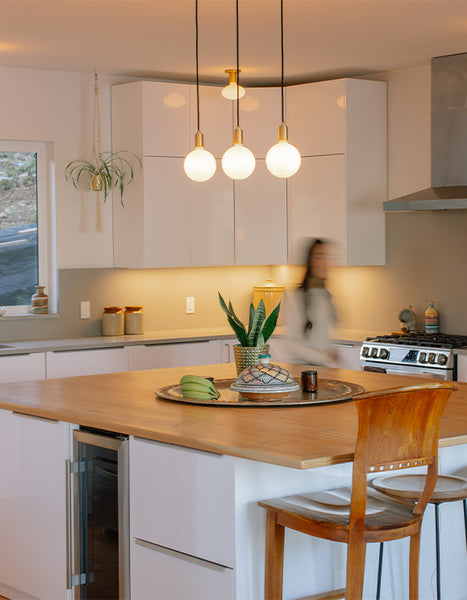Dim to Warm Lighting - Explained

We’ve called in the experts to help explain our new Dim to Warm technology, and how it differs from existing LED light bulbs.
In 2020, Tala entered the market for Dim to Warm lighting with two new product ranges – Light Engine and Sphere.
If you are new to technical lighting vocabulary, then the term ‘Dim to Warm’ may not mean much to you. Put simply, it is the process of dimming between warm and cool light.
To explain further, our Engineering Director, Bertie Pleass, and Design Director, Joe Armitage, give us the low-down on what Dim to Warm means, how it works and why you should make the switch today.
Let’s start with the basics: what does Dim to Warm mean?
Bertie: Dim to Warm is term to describe the function of the bulb that reduces the colour temperature (CCT) of the light when it is dimmed, from 2800K at 100% to 2000K as you approach 0%.

Why has Tala ventured into Dim to Warm lighting, and how does the technology differ from the existing range of light bulbs?
Bertie: Tala started out with low colour temperature (warm), low power LED light bulbs that provide a relaxing ambiance, which would suit a typical evening dining experience, reading in bed, moody hotel lobby or bar setting. As we have broadened our range to include higher power options, more suited to spaces of concentration like offices and kitchens, we increased the colour temperature to provide a more alert atmosphere.
With Dim to Warm we provide a light source that be alert and bright while cooking or working, and then dimmed to provide a warm atmosphere for hosting and relaxing in the evening.
From an engineering perspective, what were the key challenges and obstacles to achieving the final result?
Bertie: Dim to warm technology achieves varying CCT by mixing the light from two different CCT LEDs. It turned out to be very difficult to mix the LED light inside the bulb without unmixed light spilling out, resulting in the surface of the bulb looking blotchy and mis-coloured. We developed a brand new method of supporting the LED chips so that the light mixes completely before illuminating the interior space.
We also faced numerous obstacles to electrically control two separate LED sources while ensuring the high dimming compatibility expected from a Tala bulb, so these had to be overcome before we were happy with the final design.

Can you explain a little bit about the chosen colour temperatures? Why are the bulbs specified at 2800K and 2000K?
Bertie: We offer a continuous range of CCT between 2000-2800K. This range has been selected so that when dimmed you can create the very warm effect of a dimmed incandescent, almost approaching the inviting aesthetic of candlelight. At the brighter end, 2800K is a crisp white allowing a bright light for activities that need concentration and alertness.
Almost all Tala bulbs are designed to be seen, but Light Engine is designed to be hidden. Can you explain the reasoning behind this?
Joe: Tala’s design narrative starts with the light bulb and the idea that these pieces of engineering that have been around for 150 years can actually be celebrated as design objects.
Traditionally they have always been hidden behind a shade, but we flipped this idea and with LED technology created light sources which are the dominant feature, while lasting for years rather than months.
However, clearly not all light sources are design features and the Light Engine is actually the first light source from Tala which breaks our own rule. But rules are meant to be broken and with good reason: some of the key driving forces behind Tala’s design ethos are the exploration of new materials, sustainable technology and collaboration with some of the world’s best design houses. So, creating the best technical light source has enabled us to do this and although you don’t see the Light Engine when its used, you certainly know it’s there!
Dim to Warm lighting is linked with improving physical and mental wellbeing. Why is this?
Bertie: Our eyes and brains have evolved to view the world by the light from the sun and respond to the change in warmth of light as the day progresses from sunrise to noon to sunset. By illuminating our homes in a way that complements this natural process, we can support our bodies natural cycles of morning alertness and evening calmness, promoting better sleep and concentration. We’re really excited to see how our customers adapt to this way of lighting a home or workspace.

Light Engine and Sphere have both successfully launched in the UK and Europe, and Sphere has just launched in North America. What has the reaction been to the products, and how do you feel now they are finally out on the market?
Joe: The Light Engine has already made waves, particularly among the more technically focussed parts of the industry. Its performance is unrivalled in the market, and it has created a lot of opportunities both for our partners and our internal design team, with two exciting new ranges set for release in the coming months.
The Sphere range continues our history of creating bulbs that are the design feature and has been received emphatically by our partners, both to fit with their existing fixtures or to be designed around. We are using the bulbs to spearhead a large number of new design projects, which will be revealed soon!
Bertie: Both ranges have received a fantastic reception. It has been interesting to see how different the conversation surrounding each range has been, considering they offer the same illumination characteristics, but for different audiences and use cases. Sphere, which is intended to be visible in the light fixture, has received praise for its appearance and the number of fixtures it complements, with its low neck and spherical shape allowing it to sit low and tight within a pendant or table lamp. The Light Engine is designed not to be seen, but to illuminate other fixtures. Here the focus has been on the uniformity and quality of the light, the dimming compatibility with the existing dimming controls in the fixtures, and, overall, the power of the light it emits. It’s been really gratifying to see the positive response both have received, and long may it continue!



